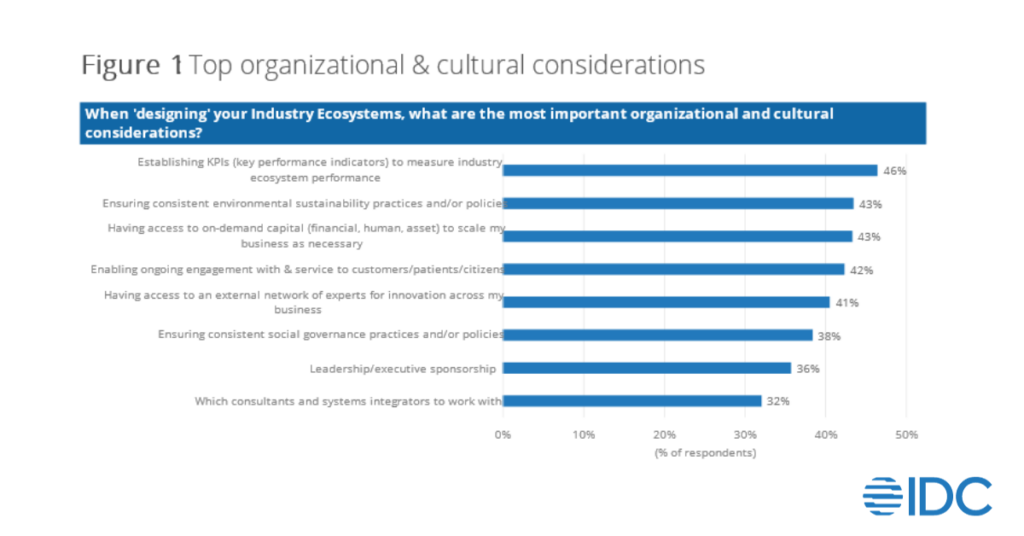Organizations in every industry continue to focus their next chapter of digital transformation on ecosystem expansion; we hear this from organizations in every industry. Working more closely with partners in and outside your core industry to support multiple use cases and initiatives is critical for success. However, it’s not always easy.
Knowing which use cases and initiatives to focus on is often not immediately evident, and resources, processes, and tools are disparate and misaligned. Our recently published IDC MaturityScape Report provides a framework for guiding organizations. Within this, we defined five key dimensions, and related sub-dimensions, that organizations and their partners must consider to be successful:
- People: Culture, Collaboration, and Leadership
- Process: Platform, Intelligence, and Metrics
- Technology: Shared data, Shared applications, and Blended digital/physical
- Operations: Availability, Governance & Trust, and Environmental sustainability
- Innovation: Rate, Management, and Openness
For details regarding each dimension and sub-dimension, see Table 1 in IDC MaturityScape: Future of Industry Ecosystems 1.0.
In this age of AI and generative AI, let’s talk about people. The people dimension was one of the most mature of industry ecosystems, according to our Future of Industry Ecosystems MaturityScape Benchmark Survey report (April 2023). This is where organizations start their journey of industry ecosystem expansion.
As they “design” which partners they should work with on which use cases and initiatives, establishing a robust culture of collaboration and innovation among industry ecosystem partners that is supported strongly by leadership is the top priority.
A primary reason for this focus is the extensive skills gap that exist in every industry, across multiple domains. These domains include IT, supply chain, production, service, and operations (IT has the biggest digital skills and resource gap consistently across every industry). Filling these digital skills and resource gaps is one of the top reasons why organizations are expanding and opening their industry ecosystems. Essentially, they are looking for “access to on-demand capital”, a top-two use case focus per figure 1:

The primary difference between thrivers (those organizations advanced in their approach in working with their partners), and survivors (those early in their ecosystem development) within this realm is that thrivers have strong leadership driving an open, extended ecosystem strategy, and their collaboration is diverse and more commonly extends beyond their core industry.
Survivors tend to have leadership that is risk averse and tactical when working with industry ecosystem partners, often settling on a standard set of pre-determined partners. An open, diverse, dynamic ecosystem culture is still weaving its way through ecosystem survivor organizations. Thrivers are quite the opposite, working very strategically with their industry ecosystem partners.
AI & GenAI for Skills & Knowledge Augmentation
With the current AI and GenAI hype, it is only natural to consider whether developing high-performing ecosystems is more about scale and having the right set of real humans working together well, or well-placed and well-used AI tech. We think it is optimally a balanced mix of both. Respondents to our recent Future of Industry Ecosystems Global Survey agree, with 36% investing or planning to invest in the near term in AI and ML in support of ecosystem initiatives. The top reasons for this, according to wave 6 of our Future Enterprise Resiliency Survey (July 2023) are as follows:
- Anticipating/Predicting Customer Needs
- Identifying Shared Data Monetization Opportunities
- Improving Supply Chain Efficiency
Industry ecosystems thrive with a diverse set of people from different backgrounds, expertise, and industries. Decision making, innovation, and efficiency are improved by taking an on demand, as needed approach to working with various resources from your partner ecosystem. However, the opportunity for knowledge, digital skills, and resource augmentation through AI and generative AI are undeniable. Some of the ways (not an exhaustive list) that ecosystems can benefit are shown in table 1:

AI use cases for Industry Ecosystems will continue to develop, as ecosystem data models become larger and more diverse, and initiatives increase in complexity and scale. As enterprises are seeing the benefits of augmenting processes, collaboration, and innovation with AI and generative AI, so will ecosystems. This is one of the reasons why, according to the IDC ICT (Information & Communications Technology) Spending Guide (July 2023), that AI Platforms have seen 37% growth over the past year, far surpassing the average ICT spending of 4%.
Strive for Flexibility through Industry Ecosystems
Wherever your organization is on the ecosystem digital transformation journey, consider the approach to working with partners on a continuum. There may be times when a simple, small team of ecosystem partners is working on a specific, short-term project, and other times when big challenges like environmental sustainability, game-changing innovation, or quality and safety require a diverse number of partners to come together as a single team for an extended period of time.
This flexible, dynamic, on-demand approach to working with industry ecosystem partners (complemented by AI) is critical to ensure the long-term viability and growth of every organization.




